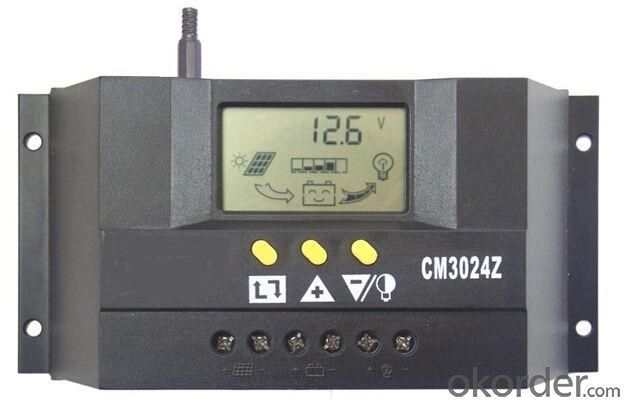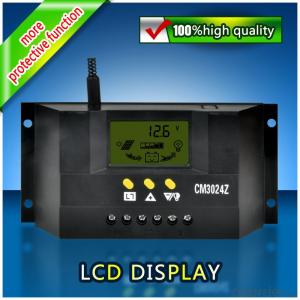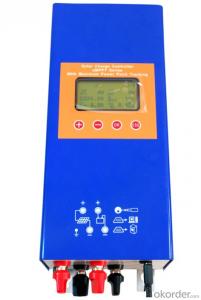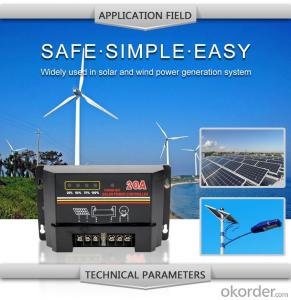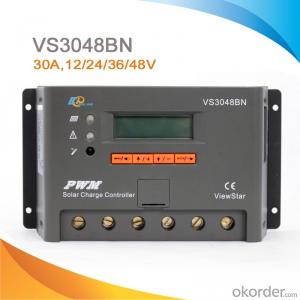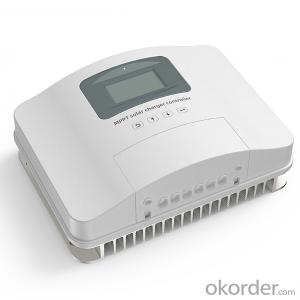Solar Powered Game Controllers with LCD Display Model CM 3024Z for Home Use
- Loading Port:
- Shanghai
- Payment Terms:
- TT OR LC
- Min Order Qty:
- 10 unit
- Supply Capability:
- 500 unit/month
OKorder Service Pledge
OKorder Financial Service
You Might Also Like
1. Structure of Solar Street Light Charging Controller for Home Use with LCD Display Model CM 3024Z
This solar street light charging controller is designed for home use, such as light in the yard. The controller of CM Series is a kind of intelligent and multi-functional solar charging and discharging controller. The products of this series consist of special LCD display which has very convenient operation interface, and all of the controls parameters can be set and adjusted according to different requirement. It is really a good example of solar energy application in daily use for home.
2. Main Features of Solar Street Light Charging Controller
· Vivid graphic symbol on LCD
· ·Easy and explicit operation with button
· ·Automatic identification of system voltage degree
· ·Intelligent charging mode of PWM
· ·Automatic temperature compensation
· ·Available for setting loading work mode
· ·Accumulative function for total Amper-hours during charging and discharging
· ·Reverse polarity protection and undervoltages protection for accumulator
· ·Overload protection and short circuit protection for accumulator
3. Solar Street Light Charging Controller Specification
Model | CM3024Z |
Rated working current | 20A \30A |
Rated working voltage | 12V/24V |
Solar panel voltage | ≤50V |
Floating charge voltage | 13.8V/27.6V |
Undervoltage protection | 10.7V/21.4V |
Undervoltage recovery | 12.5V/25.0V |
No-load loss | ≤30mA |
Circuit voltage drop | ≤170mV |
Charging mode | PWM MODE |
Temperature conpensation | -4mV/Cell/℃ |
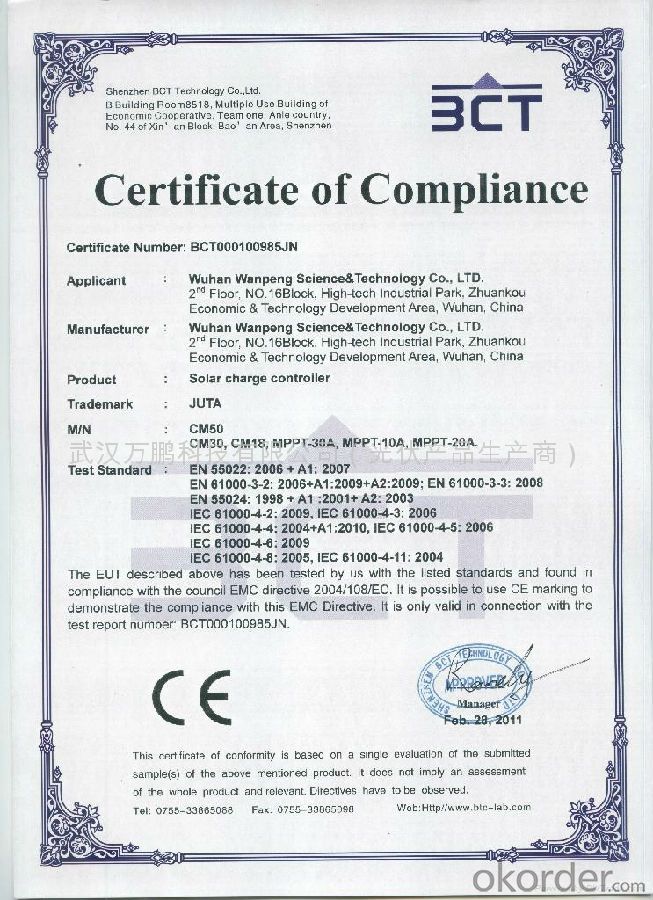
4. Solar Street Light Charging Controller Images
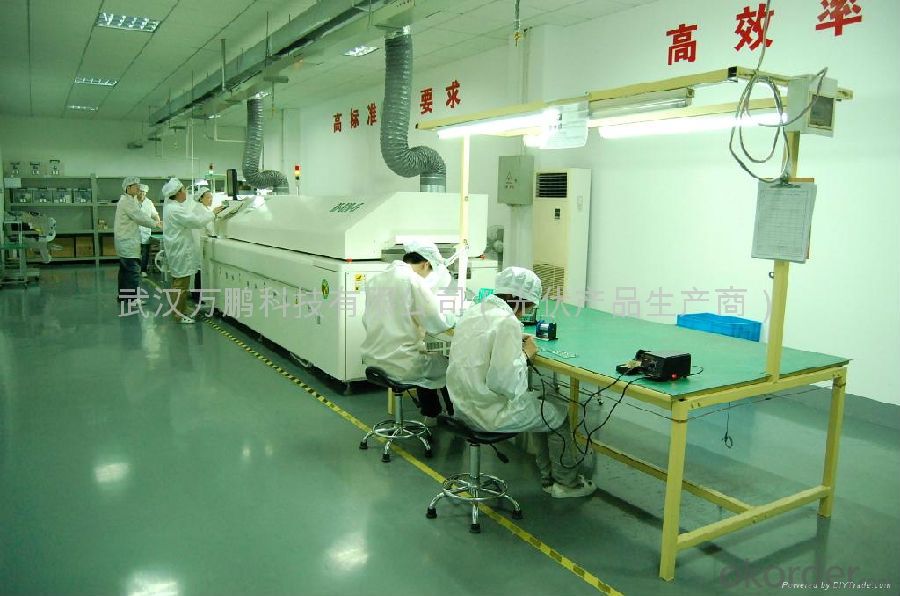
5. FAQ
We have organized several common questions for our clients, which may help you sincerely:
Q1. How to guarantee the quality of the products?
The company presses the ISO9000 quality management system control product quantity strictly, the export production all passes the relevant national company check (CE, ROHS), and get high evaluation of the customer.
Q2. How long can we receive the product after signing Sales Confirmation?
Generally speaking, if there is enough quantity of finished products which can meet the clients’ requirement, we can manage the delivery within three to five working days according to the instruction of the payment terms in the Sales Confirmation; if the products needs some time to get ready, we will arrange the delivery as soon as possible after the manufacture.
- Q: Can a solar controller be used with a solar-powered beekeeping system?
- Yes, a solar controller can be used with a solar-powered beekeeping system. A solar controller is designed to regulate and optimize the charging and discharging of batteries in a solar system. In a solar-powered beekeeping system, the solar controller would ensure that the batteries storing the solar energy are charged efficiently and that the power is distributed appropriately to power the various components of the beekeeping system, such as pumps, heaters, or lights.
- Q: What is the purpose of the battery voltage regulation feature on a solar controller?
- The purpose of the battery voltage regulation feature on a solar controller is to ensure that the batteries connected to the solar system are charged and maintained at the optimal voltage level. This feature controls the charging process to prevent overcharging, which can damage the batteries, and also prevents the batteries from being discharged too much, which can reduce their lifespan. By regulating the voltage, the solar controller helps to maximize the efficiency and longevity of the battery bank in a solar power system.
- Q: How does a solar controller prevent damage to the solar panels from hail or storm events?
- A solar controller does not directly prevent damage to solar panels from hail or storm events. However, it plays a crucial role in the overall system by regulating and optimizing the flow of electricity from the panels to the battery or grid. This helps protect the panels indirectly by ensuring that the excess power generated during storms or hail events is safely diverted or stored, reducing the risk of any electrical overload or damage. Additionally, some advanced solar controllers may have built-in surge protection features that can provide an added layer of defense against sudden power surges caused by severe weather conditions.
- Q: The principle of solar controller
- Solar controller uses high-speed CPU microprocessor and high-precision A / D analog-to-digital converter, is a computer data acquisition and monitoring and control system. It can collect the working data of the PV station in real time, obtain the working information of the PV station at any time, and accumulate the historical data of the PV station in detail, and provide the accurate and reliable evaluation of the reliability of the PV system design and the reliability of the quality of the inspection system Full basis. In addition, the solar controller also has a serial communication data transmission function, can be a number of photovoltaic systems sub-station for centralized management and remote control.
- Q: Can a solar controller be used with solar-powered pumps?
- Yes, a solar controller can be used with solar-powered pumps. A solar controller is designed to regulate the power output from solar panels and control the charging of batteries. It helps optimize the efficiency and performance of solar-powered systems, including solar pumps. By managing the flow of electricity, a solar controller ensures that the solar panels deliver the right amount of power to the pump, maximizing its performance and protecting it from damage.
- Q: What is the purpose of the low voltage disconnect feature on a solar controller?
- The purpose of the low voltage disconnect feature on a solar controller is to protect the batteries from over-discharge. When a battery is discharged below a certain voltage level, it can cause irreversible damage and significantly reduce its lifespan. The low voltage disconnect feature monitors the battery voltage and disconnects the load, such as appliances or devices, from the battery when the voltage drops below a predetermined threshold. This helps to prevent the battery from being drained too much and ensures that it retains enough charge for proper functioning and longevity. By disconnecting the load, the low voltage disconnect feature helps to safeguard the battery and optimize its performance in a solar power system.
- Q: Can a solar controller be used with a solar-powered electric scooter charging station?
- Yes, a solar controller can be used with a solar-powered electric scooter charging station. A solar controller helps regulate the flow of electricity from solar panels to the charging station, ensuring optimal charging efficiency and preventing overcharging of the scooter's battery.
- Q: Can a solar controller be used in a solar-powered swimming pool system?
- Yes, a solar controller can be used in a solar-powered swimming pool system. A solar controller is responsible for regulating the flow of electricity from solar panels to the pool's pump and other electrical components. It helps in optimizing the efficiency of the pool system by ensuring adequate power supply, monitoring battery levels, and protecting the system from overcharging or overheating.
- Q: Can a solar controller be used with solar-powered indoor retail facilities?
- Solar controllers can be utilized in solar-powered indoor retail facilities. Regardless of the setting, a solar controller remains a crucial component of a solar power system. Its primary function is to regulate the electricity flow from the solar panels to the batteries, ensuring efficient charging and preventing overcharging or damage. Thus, even in solar-powered indoor retail facilities, a solar controller is indispensable for managing the electricity generated by the solar panels. It guarantees the proper storage and utilization of this electricity to power the facility's lighting, appliances, and other electrical equipment.
- Q: How does a solar controller handle temperature fluctuations in the environment?
- The purpose of a solar controller is to manage temperature fluctuations in the environment through the utilization of various mechanisms and features. Regulating and optimizing the charging and discharging of batteries in a solar power system is one of the primary functions of a solar controller. To guarantee efficient operation in varying temperatures, solar controllers typically incorporate temperature sensors. These sensors monitor the surrounding temperature and provide feedback to the controller. Based on this information, the controller can adjust its charging and discharging parameters accordingly. In cold temperatures, the solar controller may increase the charging voltage to compensate for reduced battery performance. This prevents insufficient charging and ensures that the batteries receive the necessary charge. Additionally, the controller may modify the charging algorithm to allow for a longer absorption phase, which aids in fully charging the batteries even at lower temperatures. On the other hand, in hot temperatures, the solar controller may decrease the charging voltage to prevent overcharging and potential damage to the batteries. It may also shorten the absorption phase to prevent excessive heat buildup. These temperature compensation techniques assist in maintaining optimal battery performance and prolonging their lifespan. Moreover, advanced solar controllers may include additional features to mitigate temperature-related issues. For example, some controllers are equipped with temperature sensors specifically for the solar panels themselves. These sensors monitor the panel temperature and adjust the maximum power point tracking (MPPT) algorithm accordingly. By optimizing the panel's output voltage and current based on temperature, the controller ensures maximum energy conversion efficiency. In conclusion, a solar controller effectively manages temperature fluctuations in the environment by utilizing temperature sensors and implementing temperature compensation techniques. This enables the controller to adapt its charging and discharging parameters to different temperature conditions, ensuring optimal performance and longevity of the batteries in a solar power system.
Send your message to us
Solar Powered Game Controllers with LCD Display Model CM 3024Z for Home Use
- Loading Port:
- Shanghai
- Payment Terms:
- TT OR LC
- Min Order Qty:
- 10 unit
- Supply Capability:
- 500 unit/month
OKorder Service Pledge
OKorder Financial Service
Similar products
Hot products
Hot Searches
Related keywords



